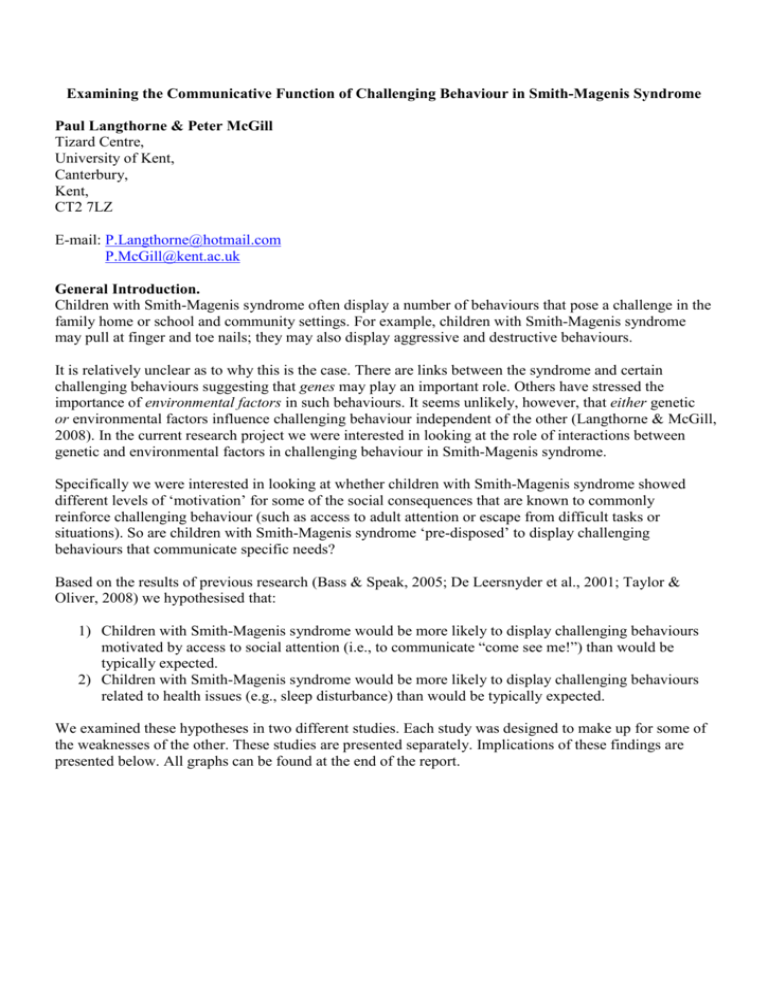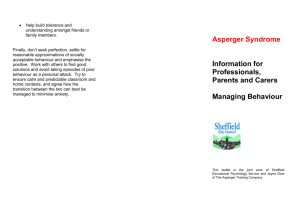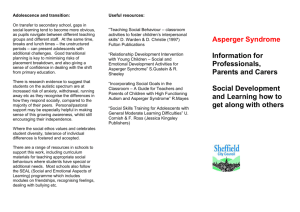Examining the Communicative Function of Challenging Behaviour in
advertisement

Examining the Communicative Function of Challenging Behaviour in Smith-Magenis Syndrome Paul Langthorne & Peter McGill Tizard Centre, University of Kent, Canterbury, Kent, CT2 7LZ E-mail: P.Langthorne@hotmail.com P.McGill@kent.ac.uk General Introduction. Children with Smith-Magenis syndrome often display a number of behaviours that pose a challenge in the family home or school and community settings. For example, children with Smith-Magenis syndrome may pull at finger and toe nails; they may also display aggressive and destructive behaviours. It is relatively unclear as to why this is the case. There are links between the syndrome and certain challenging behaviours suggesting that genes may play an important role. Others have stressed the importance of environmental factors in such behaviours. It seems unlikely, however, that either genetic or environmental factors influence challenging behaviour independent of the other (Langthorne & McGill, 2008). In the current research project we were interested in looking at the role of interactions between genetic and environmental factors in challenging behaviour in Smith-Magenis syndrome. Specifically we were interested in looking at whether children with Smith-Magenis syndrome showed different levels of ‘motivation’ for some of the social consequences that are known to commonly reinforce challenging behaviour (such as access to adult attention or escape from difficult tasks or situations). So are children with Smith-Magenis syndrome ‘pre-disposed’ to display challenging behaviours that communicate specific needs? Based on the results of previous research (Bass & Speak, 2005; De Leersnyder et al., 2001; Taylor & Oliver, 2008) we hypothesised that: 1) Children with Smith-Magenis syndrome would be more likely to display challenging behaviours motivated by access to social attention (i.e., to communicate “come see me!”) than would be typically expected. 2) Children with Smith-Magenis syndrome would be more likely to display challenging behaviours related to health issues (e.g., sleep disturbance) than would be typically expected. We examined these hypotheses in two different studies. Each study was designed to make up for some of the weaknesses of the other. These studies are presented separately. Implications of these findings are presented below. All graphs can be found at the end of the report. Study 1. An Indirect Examination of Behavioural Function in Smith-Magenis Syndrome. Method. Participants were parents of children and young people (aged 5-21 years) with an intellectual and developmental disability who displayed some form of challenging behaviour (self-injurious behaviour, aggression or destructive behaviour). Participants were drawn from 3 different groups: 1) parents of a child with fragile X syndrome, 2) parents of a child with Smith-Magenis syndrome, 3) a control group of parents of a child with non-specific intellectual and developmental disability. Parents of children with fragile X syndrome Parents of children with Smith-Magenis syndorme N = 34 N = 25 Parents of children from non-specific intellectual and developmental disability group (control) N = 30 The three groups were matched for age, level of overall adaptive behaviour and overall ratings of the severity of challenging behaviour. There were gender differences between the groups, with a greater proportion of female participants in the Smith-Magenis syndrome group than either of the other two groups. A number of assessment measures were completed as part of a telephone interview. The primary measure, the Questions About Behavioural Function (QABF; Matson & Vollmer, 1995) scale, involves asking caregivers to rate the communicative function of their child’s challenging behaviour. This was then scored across 5 different categories (attention, escape, tangible, pain-related, non-social). Results. There were both within- and between group differences in reported behavioural function. Within-group differences Whilst there were within-group differences in behavioural function for the fragile X syndrome group, the profile for children with Smith-Magenis syndrome was very different. Children with Smith-Magenis syndrome scored high across all subscales. Suggesting that children with Smith-Magenis syndrome may display challenging behaviours that serve multiple communicative functions (i.e., challenging behaviours communicate multiple needs). Between-group differences We did, however, find between-group differences in behavioural function for children with SmithMagenis syndrome. Children with Smith-Magenis syndrome scored significantly higher on the attention-maintained challenging behaviours than children with fragile X syndrome for all three types of challenging behaviour. Children with Smith-Magenis syndrome also scored significantly higher on items related to physical discomfort than either the fragile X syndrome or control group for aggression and destructive behaviours, and were significantly higher than the fragile X syndrome group for self-injurious behaviours. So, children with Smith-Magenis syndrome appear to be more likely to display challenging behaviours that communicate “come see me!” than other groups and are more likely to display challenging behaviours related to physical discomfort . The between-group data for the attention subscale are presented in graphs 1-3. The between-group data for the physical discomfort subscales are presented in graphs 4-6. Summary. The results of this initial study suggest that challenging behaviour displayed by children with SmithMagenis syndrome is more likely to be motivated by social attention than in fragile X syndrome. However, the within-syndrome profile of scores suggest that children with Smith-Magenis syndrome are likely to display challenging behaviours that serve multiple communicative functions (i.e., challenging behaviour is not solely motivated by attention in Smith-Magenis syndrome). Children with SmithMagenis syndrome also appear to be more likely than we would typically expect to display challenging behaviours related to physical discomfort. There are some limitations with this study. There are problems with relying on caregiver reports as these do not necessarily reflect the actual function served by the child’s behaviour. Because of this we aimed to follow up the initial study with a more rigorous measure of behavioural function using a small sub-sample of children from the Smith-Magenis syndrome and fragile X syndrome groups. Study 2. An Experimental Examination of Behavioural Function in Smith-Magenis syndrome Method. 8 participants with fragile X syndrome and 6 participants with Smith-Magenis syndrome were selected to take part in study 2. There were no differences in the QABF scores of those taking part in study 2 from study 1, suggesting that the groups were representative of the overall samples from which they were drawn in regards to communicative function of challenging behaviour. We used a method known as experimental functional analysis to assess the communicative function of each child’s challenging behaviour. This method involves presenting a series of role play situations to each child and seeing whether there are changes in their behaviour across any of the different conditions. Each of the role play situations differ in the trigger presented to the child and in how the therapist responds to the child’s behaviour. Each condition is designed to test a different theory about why challenging behaviour occurs. In this study we used up to six different situations These were: 1) Attention. In the attention condition the child was asked to play with some toys whilst the therapist pretended to do some work. Some brief attention (e.g., “Don’t do that you’ll hurt yourself!”) was provided if the child engaged in any challenging behaviours. This was designed to test whether challenging behaviours were reinforced by attention and served to communicate “Look at me!”. 2) Tangible. Access to preferred items was withheld. The child was given brief access to the item if he engaged in any challenging behaviour. This was designed to test whether challenging behaviours were reinforced by access to preferred items and served to communicate “I want that!”. 3) Demand. The child was asked to complete a difficult task using a series of prompts. Praise was given if the task was completed correctly. The task was removed for a brief period if challenging behaviour occurred. This was designed to test whether challenging behaviours were reinforced by the removal of task demands and served to communicate “I don’t want to do this!”. 4) Social Avoidance. The therapist provided attention to the child throughout the session. If any challenging behaviours occurred then attention was removed for a brief period of time. This was designed to test whether challenging behaviours were reinforced by the removal of social attention and served to communicate “Leave me alone!”. 5) Play. The therapist engaged in preferred activities with the child whilst providing regular attention. All challenging behaviours were ignored. This was designed to act as a control condition. 6) No Interaction. The therapist turned away from the child and faced the wall. No toys or social attention were available throughout. This condition was designed to test whether challenging behaviours were reinforced by non-social factors, such as the sensory stimulation they produced (e.g., “this feels good!”). Each of the sessions lasted for 5mins and we repeated each condition at least three times for each child. The functional analyses were conducted either at the child’s home or school, depending on parental preference. A structured criteria was used to help us provide a consistent interpretation of the function served by each child’s challenging behaviour. At the end of the study each family received an interpretation of the functional analysis results and some basic recommendations for intervention. Results. Table 1 shows the proportion of participants from the fragile X syndrome and Smith-Magenis syndrome groups who displayed challenging behaviour that met the criteria for each communicative function. Table 1. Summary of functional analysis results. Group Attentionmaintained Escapemaintained Tangiblemaintained FRAGILE X SYNDROME 0/8 5/8 4/8 SMITHMAGENIS SYNDROME 4/6 3/6 2/6 Graphs 7 and 8 below show summary data for each participant in the Smith-Magenis syndrome group. Summary. The results of study 2 were consistent with findings from our initial study. We found high levels of attention motivated challenging behaviour in children with Smith-Magenis syndrome in comparison to the fragile X syndrome group. Children with Smith-Magenis syndrome also displayed challenging behaviour that served other communicative functions, suggesting that challenging behaviour in SmithMagenis syndrome is not exclusively motivated by access to social attention. The current study is limited by the relatively low numbers involved. In addition, the reliance on relatively contrived situations may have meant that the child’s behaviour differed from when they were in natural contexts. General Discussion. The findings of the two studies suggest that both genes and environment may play a role in influencing the function of challenging behaviour in Smith-Magenis syndrome. It appears that challenging behaviour in Smith-Magenis syndrome is more likely to be motivated by access to social attention than in other genetic syndromes, such as fragile X syndrome. Children with Smith-Magenis syndrome are also more likely to display challenging behaviours related to physical discomfort than we would typically expect. These findings are consistent with other research to have looked at challenging behaviour in SmithMagenis syndrome (Bass & Speak, 2005; De Leersnyder et al., 2001; Taylor & Oliver, 2008) and extends this work by using more robust measures of behavioural function. Future research should begin to uncover the reasons as to why such differences may exist in the communicative function of challenging behaviour? Smith-Magenis syndrome is associated with chronic sleep disruption and the high scores on the physical discomfort scale of the QABF may have been indicative of this. Anecdotally, parents frequently cited sleep problems as playing a major role in their child’s challenging behaviour. Future work could examine these relations more systematically than was possible in the current project. Implications? These findings also suggest a possible avenue for the prevention and early intervention of challenging behaviour in Smith-Magenis syndrome. If we know that children with Smith-Magenis syndrome are likely to use challenging behaviours as a means of accessing attention or communicating that they are in pain or tired then we can use this information to help us teach the child different ways of meeting these needs at a very young age before challenging behaviours begin to develop. Such a strategy would help to prevent the child and their family from experiencing many of the negative consequences that often come with challenging behaviour. Acknowledgements. We would like to thank Unique for their support with this research, as well as all the families and children who took part in the study. Thanks to The Fragile X Society, The Challenging Behaviour Foundation, Dr Alex Magee (Belfast City Hospital NHS Trust), Dr John Tolmie (Yorkhill NHS Trust), Dr Alan Fryer (Royal Liverpool Children's Hospital NHS Trust) and Dr Trevor Cole (Birmingham Women's NHS Foundation Trust) for their help in recruiting participants for the study. Thanks also to Athene Kok, Agi Kozma, Dr Nick Gore and numerous MSc students at the Tizard Centre for their help with data collection and analysis. The project was funded by grants from the Economic and Social Research Council and Remedi. References. Bass, M. N., & Speak, B. L. (2005). A behavioural approach to the assessment and treatment of severe self-injury in a woman with Smith-Magenis syndrome: A single case study. Behavioural and Cognitive Psychotherapy, 33, 361-368. De Leersnyder, H., de Blois, M. C., Vekemans, M., Sidi, D., Villain, E., Kindermans, C., et al. (2001). Beta(1)-adrenergic antagonists improve sleep and behavioural disturbances in a circadian disorder, Smith-Magenis syndrome. Journal of Medical Genetics, 38(9), 586-590. Langthorne, P., & McGill, P. (2008). A functional analysis of the early development of self-injurious behavior: Incorporating gene-environment interactions. American Journal on Mental Retardation, 113(5), 403-417. Taylor, L., & Oliver, C. (2008). The behavioural phenotype of Smith-Magenis syndrome: evidence for a gene-environment interaction. Journal of Intellectual Disability Research, 52, 830-841. Study 1. Between-group differences in behavioural function. Attention Subscale. The graphs below show the mean score for each group for attention motivated behaviours for 1) selfinjurious behaviours, 2) aggressive behaviours, 3) destructive behaviours. Graph 1. Between-group QABF attention subscale mean scores. Self-injurious behaviour Mean QABF score. Attention. SIB 9 8 7 6 5 4 3 2 1 0 FXS SMS Non-specific IDD Graph 2. Between group QABF attention subscale mean scores. Aggressive behaviour Mean QABF score. Attention. Aggression. 10 9 8 7 6 5 4 3 2 1 0 FXS SMS Non-specific IDD Mean QABF score. Attention. Destruction Graph 3. Between group QABF attention subscale mean scores. Destructive behaviour 12 10 8 6 4 2 0 FXS SMS Non-specific IDD Study 1. Between-group differences in behavioural function. Physical Discomfort Subscale. The graphs below show the mean score for each group for physical discomfort related behaviours for 1) self-injurious behaviours, 2) aggressive behaviours, 3) destructive behaviours. Graph 4. Between-group QABF physical discomfort subscale mean scores. Self-injurious behaviour Mean QABF score. Physical discomfort. SIB 10 9 8 7 6 5 4 3 2 1 0 FXS SMS Non-specific IDD Graph 5. Between group QABF physical discomfort mean scores. Aggressive behaviour Mean QABF score. Physical discomfort. Agg 12 10 8 6 4 2 0 FXS SMS Non-specific IDD Graph 6. Between group QABF physical discomfort mean scores. Destructive behaviour Mean QABF score. Physical discomfort. Dest 12 10 8 6 4 2 0 FXS SMS Non-specific IDD Study 2. Summary data for Smith-Magenis syndrome participants. The graphs below show the number of standard deviations the mean for each of the different conditions were from the overall mean for each participant. Graph 7 presents summary information for those SmithMagenis syndrome participants with challenging behaviours that were at least in part motivated by access to social attention. Graph 8 shows summary information for those Smith-Magenis syndrome participants who displayed challenging behaviours that were not motivated by access to social attention. Graph 7. Summary data for Smith-Magenis syndrome participants from study 2. Participants with attention-motivated challenging behaviour. Graph 8. Summary data for Smith-Magenis syndrome participants from study 2. Participants without attention-motivated challenging behaviour.







